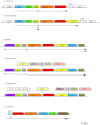Regulation of the histidine utilization (hut) system in bacteria
- PMID: 22933560
- PMCID: PMC3429618
- DOI: 10.1128/MMBR.00014-12
Regulation of the histidine utilization (hut) system in bacteria
Abstract
The ability to degrade the amino acid histidine to ammonia, glutamate, and a one-carbon compound (formate or formamide) is a property that is widely distributed among bacteria. The four or five enzymatic steps of the pathway are highly conserved, and the chemistry of the reactions displays several unusual features, including the rearrangement of a portion of the histidase polypeptide chain to yield an unusual imidazole structure at the active site and the use of a tightly bound NAD molecule as an electrophile rather than a redox-active element in urocanase. Given the importance of this amino acid, it is not surprising that the degradation of histidine is tightly regulated. The study of that regulation led to three central paradigms in bacterial regulation: catabolite repression by glucose and other carbon sources, nitrogen regulation and two-component regulators in general, and autoregulation of bacterial regulators. This review focuses on three groups of organisms for which studies are most complete: the enteric bacteria, for which the regulation is best understood; the pseudomonads, for which the chemistry is best characterized; and Bacillus subtilis, for which the regulatory mechanisms are very different from those of the Gram-negative bacteria. The Hut pathway is fundamentally a catabolic pathway that allows cells to use histidine as a source of carbon, energy, and nitrogen, but other roles for the pathway are also considered briefly here.
Figures



 C double bond of urocanate generates hydroxyimidazole propionate, which spontaneously undergoes an enol-keto tautomerization to imidazolone propionate (IP).
C double bond of urocanate generates hydroxyimidazole propionate, which spontaneously undergoes an enol-keto tautomerization to imidazolone propionate (IP).



References
-
- Ames GF. 1964. Uptake of amino acids by Salmonella typhimurium. Arch. Biochem. Biophys. 104:1–18 - PubMed
Publication types
MeSH terms
Substances
LinkOut - more resources
Full Text Sources
Other Literature Sources
Molecular Biology Databases

